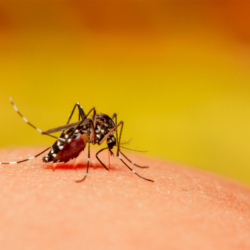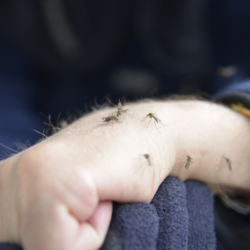Ringworm is a common dermatological disease caused by microscopic fungi called dermatophytes. These pathogens can affect both animals and humans, creating a contagious infection that deserves our attention. In this article, we will explore the scientific aspects of ringworm, from its infectious agent to means of prevention, symptoms and treatment. We will also provide you with epidemiological data to help you better understand the extent of this zoonosis.
What is the infectious agent responsible?
Ringworm is caused by microscopic fungi belonging to the genera Microsporum and Trichophyton. These fungi form filaments that colonise the skin and hair follicles. They then produce spores a few micrometres in diameter. These are the contagious elements and are particularly resistant in the environment. Dermatophytes can survive for months, even years, in the form of spores, which facilitates their spread.
The fungi responsible for ringworm feed on keratin, a protein found in hair, nails and skin. Ringworm manifests itself as rounded patches that grow from the centre outwards, accompanied by changes in skin texture and colour, as well as hair loss in the affected areas. The genera Epidermophyton, Trichophyton and Microsporum are the main pathogens of ringworm.
Trichophyton tonsurans infections are common in the United States, while cats and dogs often harbour Microsporum canis. In Asia and Africa, Trichophyton violaceum is endemic and sometimes appears in immigrants to Europe. These fungi have the unique ability to invade and proliferate in keratinised tissues such as hair, the horny layer of the epidermis, nails and claws.
Young animals, especially cats, are particularly susceptible to ringworm, which can spread rapidly in environments such as pet shops, shelters and breeding farms. Animal ringworm is a common cause of zoonosis, i.e. a disease that can be transmitted from animals to humans, with Microsporum canis being responsible for the majority of cases.
How does this disease manifest itself in animals?
Ringworm can infect all mammalian species and, more exceptionally, some birds. It is found worldwide and frequently appears in young animals. Ringworm is mainly transmitted by direct contact with an infected animal or objects contaminated with spores.
Symptoms of ringworm in animals vary depending on the species of fungus and the animal infected. In general, ringworm causes the appearance of hairless areas, often circular and well-defined. In cats and rodents, the infection can often be asymptomatic, making detection of the disease more difficult. Horses are also frequently affected by this mycosis, with rapid transmission in confined groups.
Young horses, particularly those under two years of age, are at greater risk of developing clinical signs of ringworm. Typical lesions begin as small elevations of the skin or standing hair in a circular area. These lesions evolve into hairless areas with grey scales. Clinical signs may include generalised skin eruptions resembling urticaria.
Cats infected with ringworm may present lesions on the head, face and extremities. These lesions are often subtle or mild, or even completely absent in some animals, but this does not prevent them from being contagious. In dogs, symptoms include alopecic lesions with varying degrees of inflammation and scaling.
The transmission of ringworm is facilitated by pre-existing skin lesions, such as the presence of lice or trauma associated with harnessing. Dermatophyte spores are highly resistant in the environment, making them easy to spread. Contamination can also occur through contact with contaminated objects or soil.
How is it transmitted?
Ringworm is transmitted mainly by direct contact with an infected animal or by contact with objects contaminated with dermatophyte spores. These spores can survive for a long time in the environment, making the disease easily transmissible. Public places such as schools, nurseries and changing rooms are particularly prone to the spread of ringworm.
People working in close contact with infected animals or their contaminated environment are at increased risk of contracting ringworm. This includes breeders and sellers of dogs, cats, rodents and rabbits, as well as vets and veterinary laboratory staff. Slaughterhouse, rendering service and equestrian centre staff are also at risk.
Children are often victims of ringworm, particularly on the scalp, where transmission occurs through direct contact with an animal or contaminated objects such as combs, brushes or hats. Ringworm can also be transmitted within families and schools, with untreated lesions being particularly contagious.
Risk factors for contamination include a weakened immune system, poor hygiene and excessive humidity. Dermatophytes are relatively resistant and can survive in the environment, which increases the risk of transmission. Ringworm is more or less contagious depending on the species and strains involved, which can lead to localised epidemics.
In short, ringworm is transmitted by direct contact with contaminated animals or objects. People working with animals or in contaminated environments are at increased risk. Children and people with weakened immune systems are particularly vulnerable to this zoonosis.
What are the symptoms of this infection in humans?
In humans, ringworm manifests itself with distinct symptoms depending on the areas affected. After an incubation period of around a week, lesions appear on areas in contact with animals, such as the neck, face and forearms. These lesions, known as “circinate herpes”, take the form of ring-shaped, well-circumscribed redness accompanied by itching.
When ringworm affects the scalp or beard, the lesions are often highly inflammatory and may produce pus, a condition known as “kerion”. If left untreated, these patches gradually spread, the edges become scaly and the skin in the centre appears normal. Children are more susceptible than adults to these infections.
Symptoms of ringworm also include small pimples and dandruff, sometimes with fine, scaly erythematous lesions. Hair may become brittle and the scalp may show local hair loss. Ringworm of the body manifests itself as pink to red annular patches with raised scaly edges that extend to the periphery and tend to fade in the centre.
There are several types of ringworm, each with specific symptoms:
- Ringworm: The most common form, causing hair loss in large patches or small areas.
- Suppurative ringworm: Characterised by rounded lesions (kerions) on the scalp, resulting from a major inflammatory reaction.
- Favic ringworm: A rare form caused by Trichophyton schoenleinii, manifested by soft yellowish crusts around the hair.
Symptoms of ringworm can include itching, patchy hair loss, scaly skin and brittle or discoloured nails. Each symptom reflects the body’s reaction to the fungal infection, requiring medical intervention for effective treatment.
How is it diagnosed?
Diagnosis of ringworm generally begins with a consultation with a general practitioner or dermatologist. Clinical examination is the first step in identifying the characteristic symptoms of the infection. These symptoms include rounded, red patches, often accompanied by itching, and hair loss in the affected areas.
To confirm the diagnosis, several additional tests can be carried out. One of the most commonly used tests is the Wood’s test, which involves exposing the affected areas of the skin or scalp to ultraviolet light. Certain types of ringworm fungi produce a characteristic fluorescence under this light, making them easy to identify.
Taking a sample from the affected area for microscopic examination is also common practice. Several techniques can be used for this type of examination, such as direct microscopy, fungal culture or polymerase chain reaction (PCR). A combination of these techniques can be used to confirm fungal infection and determine the most appropriate treatment.
Differential diagnosis is essential, as some symptoms of ringworm may resemble those of other dermatological conditions, such as pityriasis rosae, drug rash, nummular dermatitis, erythema multiforme, pityriasis versicolor, erythrasma, psoriasis or secondary syphilis. Careful assessment and the use of specific tests help to distinguish ringworm from these other conditions.
For animals, particularly cats and dogs, a vet can perform a fungal culture after taking samples from the animal’s coat and skin with a toothbrush. This determines whether the animal is a carrier of dermatophytes and requires treatment.
What is the appropriate treatment?
Treatment for ringworm varies according to the location and severity of the infection. Mild forms can be treated with antifungal creams or lotions, while more serious cases require oral medication.
Mild forms of ringworm can be treated with topical antifungals, such as :
- Terbinafine
- Ciclopirox
- Naftifine
- Imidazoles (clotrimazole, miconazole)
These medicines should be applied twice a day for at least 7 to 10 days after the lesions have disappeared, generally after 2 to 3 weeks. Their use effectively eliminates the fungal infection in small affected areas.
For more extensive or resistant infections, oral antifungal medication may be required. Options include:
- Terbinafine: Preferred for adults and children over 5 years of age.
- Griseofulvin: Used for children under 5 and in some cases for adults.
- Itraconazole: Prescribed for severe or resistant infections.
Regular monitoring is crucial to ensure that treatment is effective and to avoid recurrences. Doctors advise against systemic treatment for children under the age of 1 and pregnant or breast-feeding women. Unlike other drugs , terbinafine does not require biological monitoring. The latter require monitoring in line with specific recommendations.
It is essential to continue treatment until symptoms have completely disappeared and eradication of the fungus has been confirmed by follow-up tests. A clinical check-up and a second mycological sample taken 4 weeks after the start of treatment are recommended to ensure recovery.
What preventive measures are available?
Prevention of ringworm is based on rigorous hygiene measures, both individually and collectively. It is crucial to regularly clean and disinfect premises and equipment in contact with animals to limit the spread of fungal spores.
Preventive measures include :
- Cleaning and disinfection: Use of appropriate disinfectants to clean premises, cages, bedding and equipment.
- Staff training and information
- Personal hygiene: Wash hands with soap and drinking water after each contact with potentially contaminated animals or objects. Use single-use hand towels.
In the event of animal infection, hygiene measures must be reinforced:
- Treatment of infected animals: Administration of local and/or systemic antifungals.
- Disinfection of premises and equipment: Regular cleaning of surfaces and objects in contact with infected animals.
- Isolation of infected animals: Limit contact between healthy and infected animals to prevent the spread of ringworm.
It is important to have appropriate work clothing and to maintain it properly:
- Clean, well-maintained work clothes: Use separate changing rooms for street clothes and work clothes.
- Protective equipment: Wear gloves and boots when handling infected animals or cleaning premises.
Preventing ringworm requires good individual and collective hygiene, regular disinfection of premises and equipment, and training and information for people working with animals. Specific measures must be put in place in the event of animal infection to limit the spread of the disease.
Some epidemiological data…
Ringworm is a common zoonosis with a worldwide distribution. In Europe, dermatophyte infections account for around 1% of all fungal infections. The prevalence of ringworm has increased in recent years, necessitating new treatment and prevention strategies.
In 2018, an epidemic of ringworm affected 35 pupils and 3 adults in a nursery school in France. The lesions mainly affected the upper part of the body. In three quarters of cases, the lesions took the form of circinate epidermophytes. Analyses identified the dermatophyte Trichophyton tonsurans as the causative agent.
The dermatophytes responsible for ringworm are present throughout the world, with regional variations in terms of prevalence and types of fungi. Globalisation of transport and international trade in pets increase the risk of spreading treatment-resistant strains.
Children, breeders, vets and people in regular contact with animals are particularly at risk of contracting ringworm. Public places such as schools and nurseries are also conducive to the spread of the disease.
Several species of dermatophytes, such as those in the Malassezia genus, have recently been described. It is likely that others have yet to be discovered. Epidemiological surveillance is essential to detect and control new infections.
Ringworm is a common, contagious fungal infection that can affect both animals and humans. Understanding its infectious agent, modes of transmission, symptoms and available treatments is essential for preventing and managing this zoonosis. Rigorous hygiene measures and effective epidemiological surveillance are crucial to limiting the spread of ringworm.





